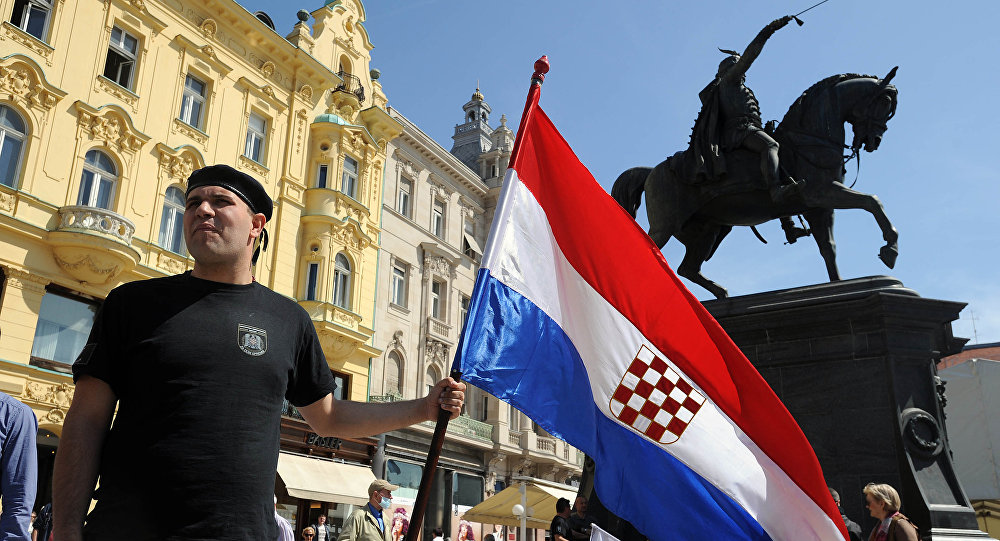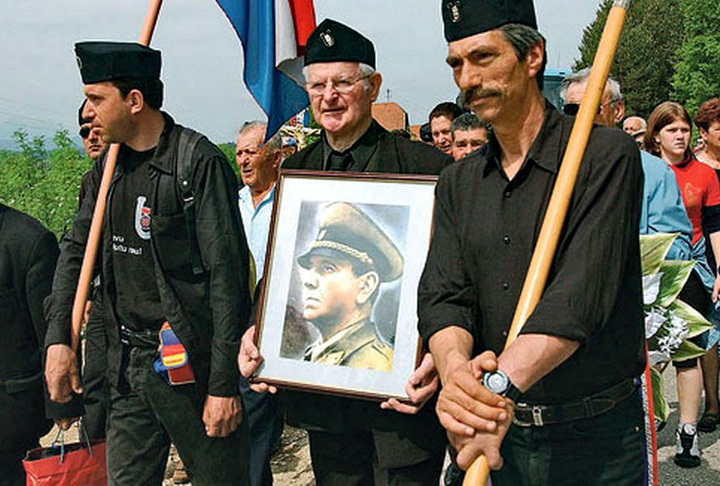
Views: 1705
In recent weeks, we have witnessed yet again how public broadcaster Croatian Radio-Television, HRT, continues to offer a platform to obscure historical revisionists.
Last week, while presenting the Festival of Patriotic Film dedicated to Goran Lederer, a Croatian journalist killed by the Yugoslav People’s Army in 1991, the organisers of the festival were given time to present highly controversial films on HRT’s widely-viewed morning show ‘Good Morning Croatia’.
Besides the fact that the main organiser of the festival is a war veterans’ association whose president and founder was Croatian war criminal Tomislav Mercep, their selection of films is symbolically even worse.
“There is also the ‘The Jasenovac Myth’ by Roman Leljak. I’m glad you’ve included him too, he’s been investigating a lot about this, so it’s going to be interesting to look at his two films,” host Liljana Vinkovic said excitedly, while holding a printed advert for the film.
“We need to go with the truth, and it is high time that we don’t divide ourselves up into left and right and that we accept the past as it is,” Smiljan Tomasevic, one of the organisers, then said.
Leljak is a Slovenian self-proclaimed researcher of Communist crimes and his documentary film and book ‘The Jasenovac Myth’ both seek to completely distort historical facts and research into the Jasenovac concentration camp, run by the Croatian fascist Ustasa movement between 1941 and 1945.
In his film, using the tactic of flashing cherry-picked documents in the face of viewers, Leljak wants to “deconstruct” what he calls the “myth about Jasenovac”, which he claims was constructed by the Yugoslav Communists. In the film, he alleges that the official, research-based name-by-name list of 83,145 deaths at the concentration camp is massively inflated from the “real” number of 1,500.
Leljak also claims that Jasenovac camp continued working as a camp until 1948, it becoming more brutal under the Communist management. This is a favourite historical fallacy in Croatia’s far-right parallel universe – which looks like Upside Down world in Netflix’s ‘Stranger Things’ series.
Actually, it is enough to look into Leljak’s personal history and the criminal deeds of which he has been convicted, as well as his contradictory statements, to see how reliable he is.
But all this wasn’t enough for HRT’s hosts, who casually talked about ‘The Jasenovac Myth’ in the context of ‘patriotic films’, although the connection between downplaying Ustasa crimes and patriotism eluded me.
During the same TV show, the hosts presented another controversial documentary, ‘A Hundred Years of Serbian Terror – From Karadjordjevic and Pribicevic to Vucic and Pupovac’, by the king of the ‘alternative facts’ genre, Jakov Sedlar.
In the film, Milorad Pupovac, an MP representing Croatia’s Serb minority, is portrayed alongside the Yugoslav king Aleksandar Karadjordjevic – who suspended parliament and political parties, introducing a dictatorship – and current Serbian President Aleksandar Vucic, who is known for his inflammatory rants against Bosniaks in the 1990s.
Photoshopping history
Sedlar’s film continues to make the same argument he has for years -that the Ustasa regime was only a reaction to the brutal Serbian repression of Croats.
He explicitly argues this in his historical quasi-documentary ‘Jasenovac – The Truth’, which caused its own share of outrage when it premiered in Zagreb in 2016.
Amid the numerous misconceptions and factual mistakes in the film, I’ll just mention an attempt to present a Photoshopped cover of state daily newspaper Vjesnik from 1945 as ‘proof’ of the lies told by the Yugoslav regime about Jasenovac.
When it was released, it was also HRT that gave Sedlar a platform to present his fraudulent film.
In May this year, HRT then offered a platform to another self-described researcher, Igor Vukic. His book ‘Labour Camp Jasenovac’ is also in the line with Leljak’s and Sedlar’s theories about the concentration camp.
According to Vukic, Jasenovac was just a mere labour and punishment camp for the enemies of the Croatian state. Like Leljak, he claims the death toll was only around 1,500, and that Jasenovac became a death camp only in the post-war years, under the Communists.
On HRT’s ‘Good Day Croatia’, show Vukic casually went on to explain how Jews were sent there only to be saved from deportations to Nazi camps. The hosts did offer an awkward unpleasant smile, but allowed Vukic to continue – after all, the show must go on.
Amid the shock created by the show, one of the hosts, Marina Medved Pulic, said that she allowed Vukic to speak because he claimed he had talked to witnesses and seen documents.
All this goes to prove that these ‘incidents’ are not exceptions, but the rule – they are part of HRT’s editorial policy.
To be fair though, HRT isn’t the only mainstream media outlet offering a platform to revisionists.
It was daily newspaper Vecernji list’s commentator Milan Ivkosic in August who praised Vukic’s book in a review entitled “Jasenovac cleansed of ideology, bias and communist forgery”, which has drawn negative reactions from Holocaust experts.
In the review, Ivkosic morbidly claimed that “there was fun in the camp”, mentioning football matches and theatre plays that inmates allegedly staged.
Proof that this wasn’t an ‘incident’ either is that Vecernji published a special magazine on the history of Jews in Croatia, in which, as well as valid scientifically-grounded articles, it smuggled in an interview with Sedlar. In the interview, Sedlar is shown as a friend of the Jews, due to his professional relations with Israeli Jews – after he claimed that Ustasa were “saving” Jews.
Even Jutarnji list, which some still consider a liberal daily, has ventured into the field of rewriting history.
In its magazine History, Jutarnji published a sensational article on the 1945 battle – more like a massive shootout – between Ustasa forces and the Serbian ultra-nationalist Chetnik movement on Lijevca Field, in northern Bosnia.
The article offered a highly inflated number of killed Chetniks; the mythologised idea of an epic battle is a fairytale nurtured over the decades in both Ustasa and Chetnik emigree circles to create the impression that they were arch enemies.
In the Croatian context, the article was probably intended to serve as ‘proof’ that the Ustasa really did fight the Chetniks – whereas, in reality, there was much more collaboration than fighting between them.
Clickbait logic
All in all, in Croatia there is a trend towards historical revisionism in society coming from the right, with mainstream media acting as a drummer, giving tempo to the movement by offering it space.
Why do they do it? First of all, historical revisionism as such is a widespread and growing social phenomenon, with the rise of a generation of Google and Wikipedia know-it-alls. Their alleged scepticism however is solely built on ‘alternative facts’, obscure propaganda and over-simplification.
Another reason for media to give space to revisionists is sheer business logic – it’s easy clickbait.
Sensationalist interpretations of history which offer one-dimensional mythologies that conveniently dovetail with the present-day realities of poor relations between Croats and Serbs are far more appealing to an average reader. In the case of Jutarnji, the idea that “the Ustase were fascists but at least they killed Chetniks” fits in perfectly with the dominant social narrative of Croats and Serbs as ancient enemies.
In other words, as media have given up on widening the horizons of their readers, dumbing down has become the only way to go.
Also, media give a platform to revisionists under the pretext that they offer space to “all sides concerned”. Therefore a historian isn’t put in a TV duel with another historian, but with a self-proclaimed researcher without any valid academic background; a geographer with a YouTube vlogger who claims that the Earth is flat, and so on.
Yes, everyone is entitled to an opinion, but this doesn’t mean that everyone’s opinion is equally valid. I may have great ideas about treating brain cancer, but I don’t expect to be invited onto a TV show to debate with neurosurgeons and medical scientists.
But why should media give up on historical revisionism if it’s bringing them readers?
I am aware that most media outlets don’t care if victims are killed for a second time when the crime is denied. And while I also know that newspapers don’t want to enlighten their readers, media should think of the very direct consequences of their work.
Not so long ago, media in Croatia, Serbia, Bosnia and Montenegro inflamed the masses. Either through fabricated news, fake readers’ letters, historical revisionism or simply by offering a platform “to all sides concerned”, media contributed to the violence of the 1990s.
The media can’t be blamed for starting the war, but it can be blamed for putting fear and hate into readers’ and viewers’ heads.
Newspapers, TV and radio stations never apologised for these crimes, nor did they sanction the journalists and editors involved. Some either ignored the whole thing or even continued to celebrate their wartime reporting.
Today, we don’t need their apologies anymore. We need them to stop before the spiral of hate gets out of hand.
Originally published on 2018-10-29
Sven Milekic is a PhD candidate at Maynooth University, Dublin, funded by the Irish Research Council under the Government of Ireland Postgraduate Programme.
Source: Balkan Transitional Justice
Origins of images: Facebook, Twitter, Wikimedia, Wikipedia, Flickr, Google, Imageinjection & Pinterest.
Read our Disclaimer/Legal Statement!
Donate to Support Us
We would like to ask you to consider a small donation to help our team keep working. We accept no advertising and rely only on you, our readers, to keep us digging the truth on history, global politics and international relations.
FOLLOW US ON OUR SOCIAL PLATFORMS












